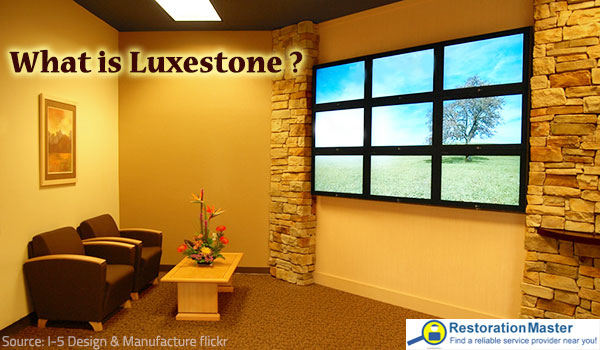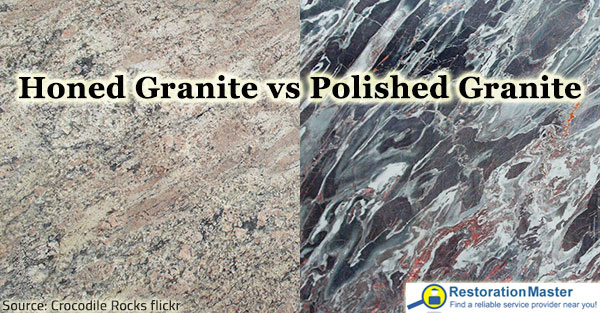Types of Countertop Finishes
When choosing a new countertop for your kitchen or bathroom, you probably have a very clear idea as to how you’d like it to look – solid-colored or patterned, in neutral tones or vivid hues, smooth and shiny or soft on the eyes and to the touch. In order to recreate your vision in reality and pick the countertop that will best suit your practical needs and aesthetic preferences, you need to review a wide variety of options and choose the right material, color, edge profile, and surface finish for your dream countertop.
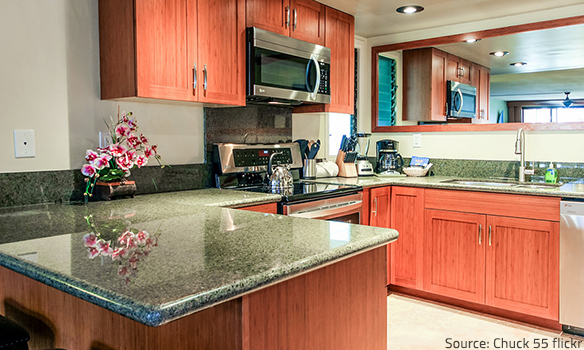
It is not only the countertop material and style that will determine the appearance and functionality of your new kitchen feature, but the type of finish you choose as well.
If you decide on a natural stone countertop (the most popular choice among contemporary homeowners), it won’t be only the specific slab and style you choose that will determine the appearance and functionality of your new kitchen or bathroom feature. Improbable as it may sound, the countertop finish can also make a great difference in the way your countertop looks, feels, and performs – it can change the stone’s reflectiveness, its maintenanceMaintenance is the routine care, inspection, and repair of a... More requirements, and overall resistance to wear and tear.
Different types of finishes result in different textures and appearance and add a unique look and feel to the countertop – they can highlight the colors and patterns of the stone, decrease the visibility of stains, and reduce the porosity of the slab. Every type of finish has its own specifics and you need to be well aware of the advantages and most appropriate uses of each in order to be able to make an informed decision about your own kitchen or bathroom renovation project.
Here is a detailed review of the most popular types of stone countertop finishes:
Polished Finish
The polished shine of granite is the first image that comes to mind when thinking of kitchen countertops. It is no wonder that a stylish, elegant countertop is immediately associated with the high gloss look of a polished finish, considering how common and widely spread it is. The brilliant, reflective sheen and smooth, glassy feel of polished countertops have, in fact, become the norm in contemporary kitchens and bathrooms. And there is a good reason for that:
- A polished finish brings out the richness of the color as well as the true character of the stone and allows its natural beauty to show through. It results in a highly reflective, mirror-like surface that makes the kitchen or bathroom appear more spacious than it is, and adds luxury and elegance to the interior décor;
- Polished finishes are less porousPorous describes a material that contains small openings or ... More than other types of countertop finishes and make for smooth, hygienic, and easy-to-maintain surfaces which are perfect for meal preparationPreparation is the steps taken to ready a property, equipmen... More areas.
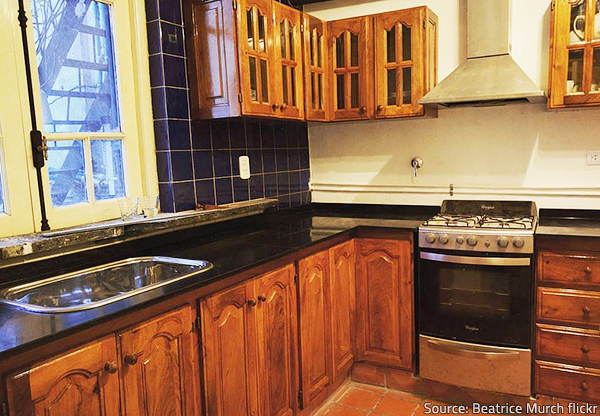
The glamorous shine of polished countertops has become the default image of an elegant, stylish kitchen.
A polished finish is achieved through a honing and buffing process during which the stone is ground with fine abrasives until it develops a natural shine of its own. The polished stone can retain its high-gloss look for years and even if the shine starts to fade, the countertop can be easily buffed and polished again. What’s more, the polished finish is the least porousPorous describes a material that contains small openings or ... More of the different countertop finishes, so it is great for preventing stains, can be easily cleaned, and does not need to be sealed as often as the other types of finishes.
Good to remember:
- In order to maintain the luster of polished finishes and prevent etching the smooth surfaces, you need to be very rigorous when caring for your polished countertops – use appropriate cleaners and safe cleaning techniques (as specified by the manufacturer) and have the stone professionally resealed when necessary;
- Have in mind that a polished countertop will inevitably draw a lot of attention and become the centerpiece of the room, so you may need a subtler finish if you want to highlight another element of your home décor or if you already have other reflective surfaces in your kitchen or bathroom.
Honed Finish
Often referred to as a matte finish, the honed finish – one of the hottest countertop finishes in recent years – is smooth to the touch and creates a soft, satiny feel. Honed surfaces are not reflective and shiny like polished ones, but they accept and redistribute natural light with an incandescent effect and add a lot of charm and rustic beauty to the ambience.
The finishing process is similar to the one used for creating polished finishes, but it stops before the stone becomes shiny, leaving it with a satin or matte appearance. The resulting surface has a subtler, more natural look and doesn’t show scratches as easily as a polished finish. What’s more, the honed finish conceals flaws and natural imperfections of the stone better than a polished finish because it lacks the high level of reflection typical of glossy surfaces.
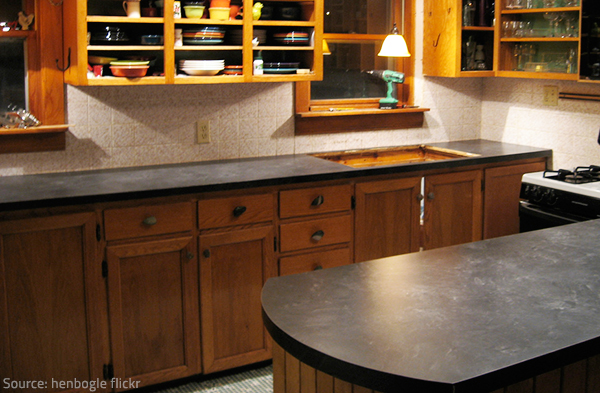
Matte countertops have a casual, rustic look and feel that is rapidly gaining popularity among contemporary homeowners.
A honed finish, however, doesn’t show the color and texture of the stone as well as a polished one. Besides, it is more porousPorous describes a material that contains small openings or ... More and, therefore, more prone to staining and more difficult to maintain (honed countertops require frequent resealing).
While a polished finish is the most popular choice for granite countertops, a honed finished is generally considered to be the best option for marble counters, as it doesn’t detract from the delicate veining and contrast of marble.
Good to remember: Honing can fade the color of a stone which is more noticeable on darker materials.
Leathered Finish
One of the newest countertop finishes, a leathered or brushed finish brings out the natural characteristics of the stone. Its distinctive rough look is created with the help of an abrasive diamond brush, applied to a honed surface – depending on the mineral content of the stone, several layers of shine and matte appear alternatively on the finished surface, resulting in a velvety, textured appearance that is reminiscent of leather. The brushed finish doesn’t reflect any light, giving the stone a rustic, more natural look.
Since the leathering process seals the pores of the stone (reducing its susceptibility to stains) and the non-reflective brushed surface easily conceals flaws and smudges, this type of finish is perfect for heavily used areas and outdoor applications. Have in mind though that leathered countertops need to be cleaned with a microfiber cloth and a suitable cleaning agent on a daily basis in order to retain their good look and feel for a long time.
Good to know: A leathered finish is widely preferred for darker granite slabs, as it retains the color of the stone, ensures higher resistance to stains than a honed finish, and hides natural imperfections and smudges better than a polished finish.
Flamed Finish
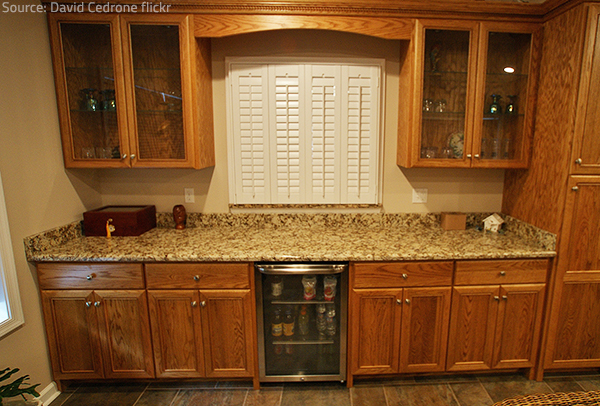
Whatever type of finish you choose for your new countertop, it is certain to bring a lot of charm, comfort, and value to your home.
A flamed finish is created by exposing the stone to intense heat. The extremely high temperature causes the individual grains in the stone to burst and change color.
This results in a rough texture with a natural, faded appearance. The colors are muted like tan or charcoal.
A flamed finish is excellent for exterior applications, such as outdoor kitchens.
Good to remember: Granite is the only natural stone that can have a flamed finish.
Caressed Finish
Caressed finish is created by adding some shine to a leathered finish. The raised areas of the stone are polished to achieve a beautiful sheen, giving the surface an elegant, yet rugged appearance. This process seals the pores of the stone (not as much as a polished finish but more than a leathered finish), making the caressed finish very suitable for granite kitchen countertops.
Other types of granite countertop finishes (River Washed, Sandblasted, Tuscan, etc.) are mainly used for decorative purposes as they are extremely porousPorous describes a material that contains small openings or ... More and very difficult to clean.
The different types of kitchen countertop finishes have different pros and cons, but all of them will add value and comfort to your home. Your final choice will depend on your personal taste, your existing interior decor, and the location of your new countertop.











